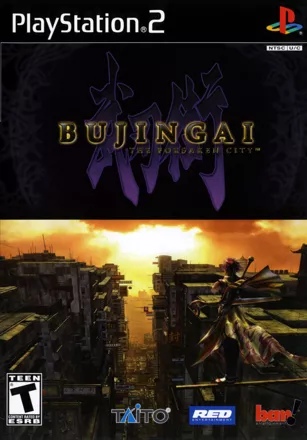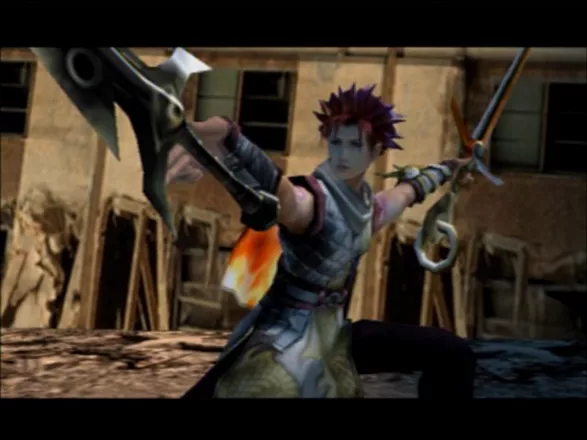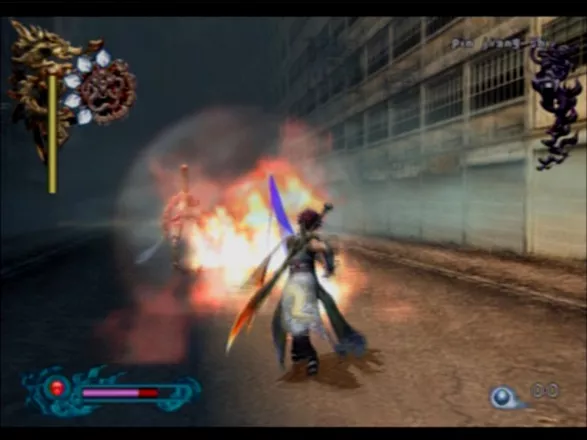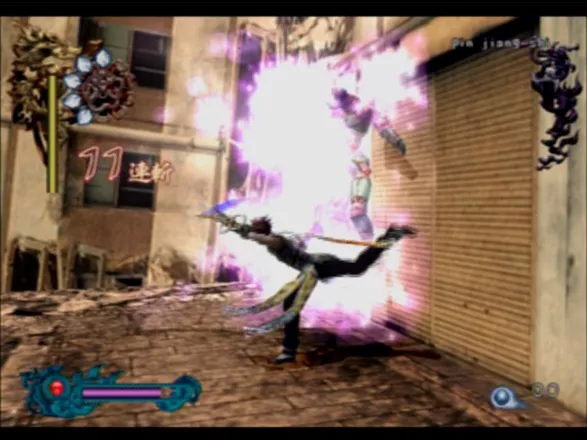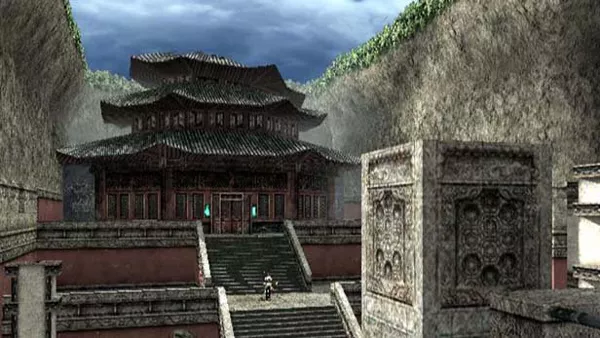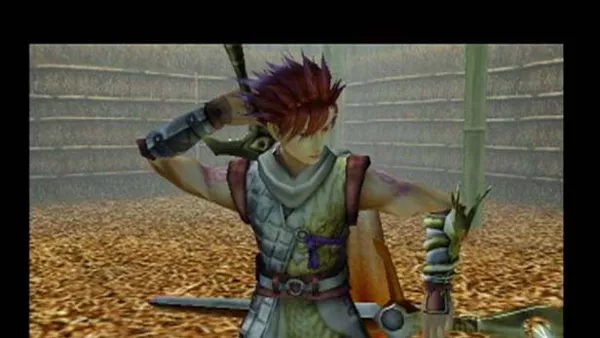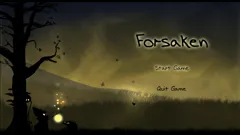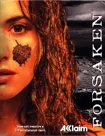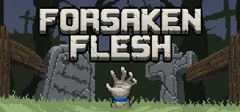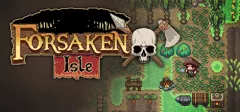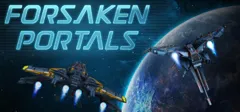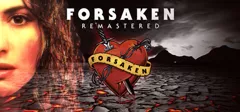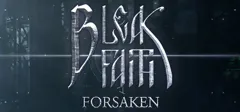Bujingai: The Forsaken City
Description official descriptions
The year is 22XX, the world civilization collapsed due to the lack of power after the explosion of a nuclear reactor. You are cast in a role of Lau, main protagonist whose character is modeled after the J-POP singer Gackt. However, your friend Lei turned on the dark side and is set to destroy what is left of the world and your plan is to stop Lei by any means necessary. The entire gameplay is very similar to that of Devil May Cry games, you can jump off the walls, performs various sword attacks, and use special magic attacks while battling the minions of darkness.
Groups +
Screenshots
Promos
Credits (PlayStation 2 version)
236 People (194 developers, 42 thanks) · View all
| Lau Wong | |
| Rei Jenron |
|
| Yohfa |
|
| Naguri Tensai |
|
| Scenario |
|
| Original Character Design |
|
| Art Concept | |
| Original Title Logo | |
| Game Design | |
| Game Concept Design |
|
| Creature Design | |
| Art Director | |
| Chief Programmer | |
| Motion Director | |
| Cut-Scene Storyboard Artist |
|
| System | |
| Stages | |
| System | |
| Player | |
| Creatures | |
| [ full credits ] | |
Reviews
Critics
Average score: 76% (based on 12 ratings)
Players
Average score: 2.7 out of 5 (based on 5 ratings with 2 reviews)
The Good
Gackt? In a Wuxia-based swordplay hack-n-slash? Count me in.
Bujingai is an under-the-radar action game that came out in 2003. Starring famed J-Pop artist Gackt and featuring some pretty swordplay graphics, I just had to get it after seeing a segment of it on TV.
The story follows as such: In the distant future, humans tinker with nuclear power which soon goes awry and annihilates 70% of the human population. This somehow opens gateways to demon worlds. It is now 679 M.A. (Martial Age) and Lau Wong returns to one of the last few human cities to defeat the apparent source of the demons, his former friend Rei Jenron.
Ok so the story may have not been the thing that attracted you to the game. It most likely was the pretty graphics and gameplay. Indeed that's what hooked me. Lau's weapons are a pair of swords and each swing leaves a pretty trail of colors behind. In fact, most things (other than running and jumping) leave a pretty color. Dashing, gliding, kicking, they all leave pretty colors. How you get to witness these pretty colors is all the more fun. Gameplay is broken down to four parts. There is the weak slash, jump, magic, and a spinning slash. The spinning slash is out of the ordinary since most action games like this usually have a strong attack. I liked that a move that I would expect to have to do a weird combination could be executed by a button. You are given the traditional lifebar, but in addition you also get defense points. Defense points determine how much damage you can take blocking before you are completely open to attacks.
You can promptly murder your enemy in a barrage of straight slashes, but why would you do that? One of the key points in this game is that its based on the Wuxia genre of Hong Kong Cinema. You know, those movies where gravity doesn't exist. This means that Lau can launch his enemy into the air and he can make them stay there by hacking at them mid-air. How you launch an enemy into the air is part of a set of three potential actions. By attacking normally and then pressing "Triangle" gives you a split-second decision on what you want to do. Pressing "Triangle" again spin-slashes, while pressing "Circle" uses magic and "Square" sends Lau kicking away. Again, all leaving pretty colors in their wake.
In a fantastic cinematic display, you can also engage fighting sequences. When you attack your opponent, they may also attack at the same time which triggers a scene in which you duke it out with your enemy with bright colors swirling around everywhere. These get especially more intense and beautiful on later levels when your opponent will either jump into the air and you can follow to engage a mid-air jousting match or counter your moves with his own. You still have the option to attack until one's defense points are all gone or you can just jump out of the sequence. It is definitely worth doing just for the beauty of it.
Magic is also usable here. They are found in boxes scattered around the different levels. You are given a diverse array of spells of varying levels. They could be used as offensive, defensive, or enhancing (I seriously never thought I'd be using those three terms again in a review so soon). Spells range from a giant fireball, a missile-shooting attack, or defensive swords surrounding Lau. Each spell takes up a piece of a Magic Gauge. Lower level spells take up less space while higher level spells take up more. You can choose different spells from a menu opened by pressing "Select".
As for the main game itself, you are sent to eight different lands on different missions while having a temple as sort of your recon point. You will be sent to cities, temples, and eventually the moon. Here you face your enemies. They come in all shapes and sizes and you will encounter plenty. Enemies are all of different variety and have different ways of causing harm. The sub-boss enemies are where the fun lies. Enemies called Overlords are the aforementioned enemies that grant longer cinematic fights. These guys are just awesome in which their stats usually match yours and so do their moves.
The missions themselves are very straightforward. Point A to Point B and annihilate what's in-between. The earlier missions are easy to breeze through, but around the third or fourth mission is when you feel the difficulty slowly increase. It soon builds up to the almost unforgivable level of the Cloud Sea.
You are able to level up your different stats. Your enemies drop orbs which can be used to upgrade health, attack, defense, power of magic, and length of magic meter. What I liked a lot was that each upgrade was reversible. It gave a lot of freedom to tinker around with what it was like with a full attack upgrade and whatnot.
The amount of unlockables and what is unlocked is amazing. You are given interviews and movies featuring the cast of the Japanese version. Seeing each actor talk about themselves and their experience with the game is something I think more games need. There is also an unlockable costume, cutscene viewer, and the ability to view every single character in the game. How you unlock these is by collecting gold coins scattered throughout the lands.
The different difficulties give more reason to play through. Not only do they rearrange the levels, only a certain amount of gold coins are available in a difficulty. Therefore, to completely unlock everything, you must play through all difficulties.
One of the more quirky things I liked was in the final battle if you attempted suicide, your enemy would save you so he could kill you and vice versa. Very nice touch.
The Bad
Why oh WHY am I always attracted to games that have tons of potential, but don't deliver?
Let's start with the story. I've played this game many times and I'm surprised at how confused I still am with this game. Although very cool, why in the world is Lau flying a comet back to Earth? Where was he before? What the hell is the Martial Age? Again, cool sounding, but I thought this was in the future. I think I remember reading the manual about how the nuclear explosion granted everyone powers, but that still doesn't explain the M.A. to me. Maybe they blew themselves up so bad they had to revert back to ancient traditions?
Which brings me to another point. If I didn't have the manual, I would've been scratching my head. Would I have guessed a nuclear explosion in the future caused all this? No. Why? Because none of it is explained in the game. The game thrusts you into the story as if you knew all about it. Would it have killed to show the nuclear explosion or to at least see the portal pouring out demons? Like I said, it had tons of potential, but it fell flat.
Characters are uninteresting all around. Lau, despite his androgynous appearance, had potential to fit amongst the ranks of hyper-action heroes like Dante and Ryu Hayabsua, but he is just dull which is inexcusable. How in the world do you get someone like Gackt to be in the game, provide the motion capture, likeliness of the character, and not give him any dialogue to express any type of thought? Even Gackt expressed his shock when he heard he had no dialogue other than saying the spell names and grunting. This was the perfect opportunity and it was just washed away. You don't care about him because you don't know anything about him because the developers chose to go this route! For shame. Not to mention the fact that its Gackt. A musician. Yet there was no music composed by him. The only thing that could be used to sum this up is "Wasted Opportunity".
There are only three other characters. Lau's teacher Naguri Tensai is some master, but I didn't care. Yohfa is the mysterious woman who guides Lau to the different worlds. Rei Jenron is a non-scary villain who feels he needs to shout he's a demon too much. Sure they may have been a tad more interesting in the Japanese version, but the English dubbing didn't do any justice. Naguri sounded like he was trying to appear commanding but he instead comes out as if he's in pain. Rei wasn't all that bad actually, but his dialogue was horrendous. When you have to traverse a whole level with him in the background declaring his turning to the demon side over and over, you just want to slap someone. Yohfa was just unusual. She was such a calm woman which I don't mind. However, when a scary pale human-turned-demon jumps out of a portal and kidnaps you, I'd be anything but calm. Instead of at least trying to slap away the attacker, she calmly tells (not even beg in typical damsel in distress style) Lau to save her. She was just emotionless in everything she did.
Graphics are mixed. Levels are very gray and bland. Only three levels stand out to me because of their bright colors, something the other five severely lacked. Your enemies are just as ugly. Other than the bosses and Overlords, everyone needs to be hit with four different buckets of paint. They are either one or two colors, or gray. And that is simply a no-no to someone who is just attacking you and just radiating color. The four main characters stand out since they were obviously given more detail. The CG scenes are impressive. My only gripe was that Lau's hair looked like flaps of paper.
There aren't many bosses, but what can you expect from such a short game? There are only five bosses and you fight two (one including Rei) of them twice. There isn't much a reason why you fought them twice. They just reappeared for the hell of it. In fact, there isn't much of a reason for anything. Why send Lau to those different worlds? Where are they even located? Why in the world can you die of the cold when in the opening he traveled through space?
Combat gets repetitive quickly. It is mainly because the enemies are simply no match for you. Those cinematic battles? Don't do them with your common enemies since 100% of the time you win. Combat is saved by the upgraded attack which prolongs your combo, but soon even that gets stale. Why not have more weapons? I'd have loved to see all sorts of swords.
Magic collecting is...bizarre. You are able to get Level 2 spells before Level 1. Why? Some spells don't even have a Level 1. There is no point in using magic except for the one mission that actually requires it. Most enemies die by your awesome sword and you will most likely forget you have magic.
Lastly, its short. This game could've been expanded into a grand adventure and rival other hack-n-slash games, but it chose not to. Being Taito's 50th Anniversary, you'd expect something grand.
And I won't knock on Lau's androgynous look. However, I will say this: I would never have expected his paints to look like that and from the storyboard art of Lau, I didn't see any make-up anywhere.
The Bottom Line
It seems like I hate the game, but I really don't. I'm just disappointed at the wasted potential from its story to its characters. Its worth playing simply for its sheer beauty. Buying it is just asking too much, but its definitely a good title to rent due to its length.
PlayStation 2 · by Hiryu (6) · 2008
The Good
This game, as Hiryu pointed out, was Taito's 50th anniversary release when it was first published in Japan in 2003 (although the European version, Bujingai: Swordmaster, which is the version I am reviewing, was released in 2005). It is a pity that Taito, which was once hailed as 'the king of the late NES era (1992-94)', and which is popularly known for the creation of some of the most coveted games in the NES library, such as Little Samson (1992) and Panic Restaurant (1992), has now fallen into a state of virtual obscurity. In fact, it only stands to reason that Bujingai, which should have been the franchise that symbolised Taito's transition to the epoch of modern console gaming after the millennium, is now cemented with an aura of 'lost potential', as Hiryu put it. So before I describe the game's positive features, it is fundamental to understand that Bujingai should have been so much more than it is. Before I proceed, I must clarify my critical position. Although I will focus on the positive aspects of the game in the section, it is important to understand that, unfortunately, in Bujingai the good is tarnished by the bad, more specifically by the ashes of wasted opportunity. The game's story may have a good concept behind it, for example, but it is ultimately sullied by very poor exposition. One of the game's most redeeming features is undoubtedly the game's artistic direction. Which is probably no surprise, since Bujingai was designed by Hiroshi Aoki and the game's characters were designed by Toshihiro Kawamoto, whose credits include the anime television series 'Cowboy Bebop' and 'Wolf's Rain' (source: Wikipedia). From Lau Wong's quasi-feminine appearance and costume to the kaleidoscope of colours that is left behind every time Lau swings his words, Bujingai is a really scintillating game, despite the occasionally dull level. Yōsuke Kuroda, the game's scenario writer, described Bujingai as ''a game with an 'Asian flavor' as seen through Japanese eyes'' which focuses on imagery using Asian mythological creatures like the dragon and phoenix; which is also manifested in the ''beauty of the flow of action during the sword fighting scenes''. All of these features contribute to Bujingai's distinctive Asiatic and mythological style. Indeed, IGN's Jeremy Dunham has stated that Bujingai's ''unique approach to the genre isn't necessarily found in gameplay, but rather, it's style and presentation.''
That is not to say that the gameplay is substandard. It is true that most enemies in the game, except the bosses, are simply no match for the simplest of Lau's combos. But it is very gratifying to pull off. I particularly enjoy it when a 'clashing sequence' (''when an enemy strikes you from the front with a series of blows, you automatically become locked in a whirlwind of swordplay called a clash'' - James Hogwood) is executed, although in my case it was more a matter of luck than skill in this game. This aspect of the gameplay, among others, does indeed offer a ''fantastic cinematic display'' to Bujingai, as Hiryu notes in his review.There is also an extensive arsenal of spells at your disposal, which add another dimension to the gameplay and are found scattered in crates throughout the game's stages.
What is left to discuss are minor points. There is a lot of bonus material to unlock by collecting a series of coins which are hidden in some of the stages. Unfortunately, the European (Pal) version is different from the US (NSTC) version in this regard, as even after collecting 55+ coins I did not unlock anything besides some character displays and a different costume for Lau. Playing the game on hard and extreme unlocks even more secrets, so there is a fair amount of replayability to this game as well for the 'collectionists' out there.
The Bad
First of all, there is the game's confusing story. The game's case advertises the story as follows:
''Lau Wong has finally returned to reality after having been banished for 400 years in a parallel world. During his long exile he has trained his mind and body for the ultimate showdown against Rei Jenron - his old friend who betrayed him. It's now time for revenge, brandish your swords and prepare your magic skills for the final battle.''
That is basically the entire explanation you will get, so do not expect any exposition throughout the game's cut scenes. Indeed, the game's cut scenes leave more questions asked than answered. Almost nothing is revealed in the cut scenes about the characters, except maybe their motives. Likewise, almost no backstory is given, you might as well just explain everything to yourself as you are playing the game. It is a shame really, for there was a lot the writers could develop with regards to the story and plot. This is the first layer of wasted potential that permeates throughout Bujingai.
It is not so much that the game starts in media res or that the story is not the reason why this game is interesting for buyers in general, as Hiryu argues. I believe that the game required a proper narratorial thread that would have interweaved the game's storyline together. This could have been easily achieved with the inclusion of backstory explanations. Furthermore, as beautifully rendered as the cut scenes are, especially considering the year the game was first released in, they are very disjointed and confusing. 'What happened? How did I end up here from there?', are both questions I had to ask myself in bewilderment while watching Bujingai's brief cut scenes at one point or another. At one part, I honestly had to find and rewatch a particular cut scene on youtube to understand how I ended up on the moon while fighting the game's last stage boss, Rei.
One of the worst crime this game commits, however, is that it completely squanders the talent of the popular artist Gackt in this game. You get the feeling that Taito just wanted to attach a big celebrity to Bujingai in the hope that it would make the game much more marketable and nothing else.
I already mentioned that the story and characters are one-dimensional, but so is the finished product that is Bujingai. There is simply nothing to recommend it besides what it actually is, a pretty, button-mashing action game inspired by Asian mythology. I sincerely wanted to like this game, even though I am not a fan of the genre of Wuxia cinema as such. Honestly, I am not Gackt's biggest fan either. But with a little more effort and inspiration, Bujingai could easily have been the next Devil May Cry. As it is, it is worth remembering only as Taito's lacklustre attempt to revive its standing in videogaming.
The Bottom Line
Bujingai is one of the biggest disappointments in videogaming that I have ever experienced, even if Bujingai isn't necessarily a bad game. It just reeks of the odour of wasted opportunity to be of any real enjoyment to anyone
PlayStation 2 · by Carmelo Lia (42) · 2016
Trivia
Protagonist
Believe it or not but there is this huge controversy over if the main character Lau, modeled after the Japanese pop singer Gackt Camui, is a man or a woman. Many people say man obviously for his voice and his name. Others say woman because of his looks. In the end, Lau is really a man.
Information also contributed by NightKid32
Analytics
Upgrade to MobyPro to view research rankings!
Identifiers +
Contribute
Are you familiar with this game? Help document and preserve this entry in video game history! If your contribution is approved, you will earn points and be credited as a contributor.
Contributors to this Entry
Game added by MAT.
Additional contributors: Roedie, Patrick Bregger.
Game added October 21, 2004. Last modified December 6, 2023.
